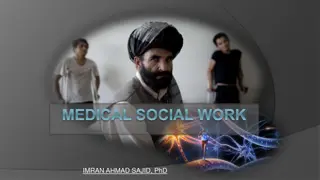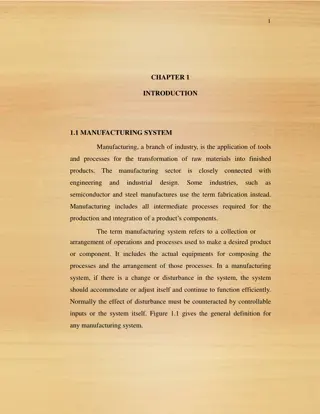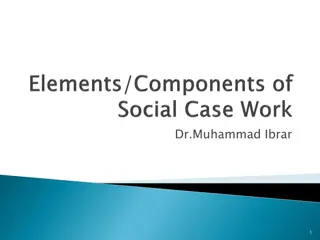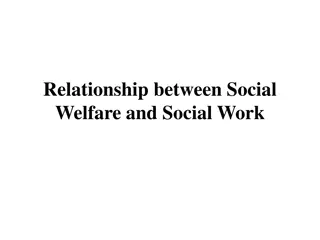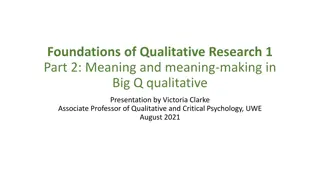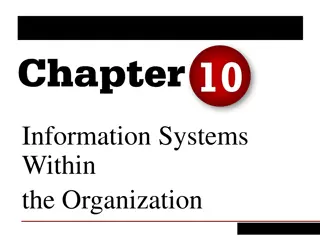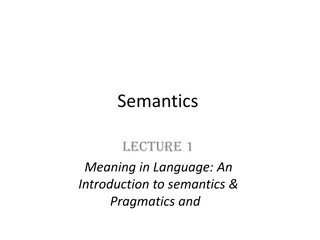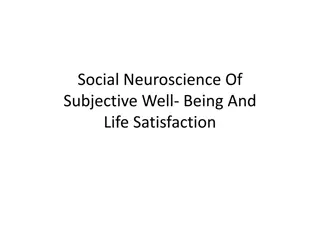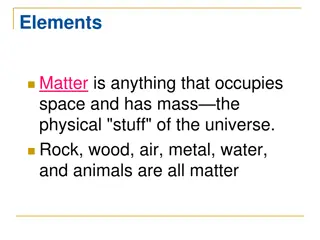Social Systems: Meaning, Elements, Characteristics, and Types
Social systems are orderly arrangements of social interactions based on shared norms and values. Talcott Parsons introduced the concept in modern sociology, defining it as an interrelationship of social actors interacting based on shared cultural norms. Social systems encompass various subsystems like economic, political, and religious, all interconnected within their environment. Elements of a social system include faiths and knowledge, sentiment, end goals, ideals and norms, status-role, role, power, and sanction.
Download Presentation

Please find below an Image/Link to download the presentation.
The content on the website is provided AS IS for your information and personal use only. It may not be sold, licensed, or shared on other websites without obtaining consent from the author.If you encounter any issues during the download, it is possible that the publisher has removed the file from their server.
You are allowed to download the files provided on this website for personal or commercial use, subject to the condition that they are used lawfully. All files are the property of their respective owners.
The content on the website is provided AS IS for your information and personal use only. It may not be sold, licensed, or shared on other websites without obtaining consent from the author.
E N D
Presentation Transcript
Social System Meaning, Elements, Characteristics and Types Sr. Jisha Chakkunny M PG Department of Sociology
The term system implies an orderly arrangement, an interrelationship of parts. In the arrangement, every part has a fixed place and definite role to play. The parts are bound by interaction. To understand the functioning of a system, for example the human body, one has to analyse and identify the sub- systems (e.g. circulatory, nervous, digestive, excretionary systems etc.) To understand how these various subsystems enter into specific relations in the fulfillment of the organic function of the body.
Social system may be described as an arrangement of social interactions based on shared norms and values.
Meaning of Social System: It is Talcott Parsons who has given the concept of system current in modern sociology. Social system refers to an orderly arrangement, an inter relationships of parts. Society is a system of usages, authority and mutuality based on We felling and likeness. Differences within the society are not excluded.
Definition A social system may be defined, after Parsons, a plurality of social actors who are engaged in more or less stable interaction according to shared cultural norms and meanings Individuals constitute the basic interaction units. But the interacting units may be groups or organisation of individuals within the system.
The social system, according to Charles P. Loomis, is composed of the patterned interaction of visual actors whose relation to each other are mutually oriented through the definition of the mediation of pattern of structured and shared symbols and expectations.
Social system is a comprehensive arrangement. It takes its orbit all the diverse subsystems such as the economic, political, religious and others and their interrelation too. Social systems are bound by environment such as geography. And this differentiates one system from another.
Elements of Social System: 1. Faiths and Knowledge: 2. Sentiment: 3. End Goal or object: 4. Ideals and Norms: 5. Status-Role: 6. Role: 7. Power: 8. Sanction:
1. Faiths and Knowledge: The faiths and knowledge brings about the uniformity in the behaviour. They act as controlling agency of different types of human societies.
2. Sentiment: Man does not live by reason alone. Sentiments filial, social, notional etc. have played immense role in investing society with continuity. It is directly linked with the culture of the people.
3. End Goal or object: Man is born social and dependent. He has to meet his requirements and fulfill his obligations. Man and society exist between needs and satisfactions, end and goal. These determine the nature of social system. They provided the pathway of progress, and the receding horizons.
4. Ideals and Norms: The society lays down certain norms and ideals for keeping the social system intact and for determining the various functions of different units. These norms prescribe the rules and regulations on the basis of which individuals or persons may acquire their cultural goals and aims.
5. Status-Role: Every individual in society is functional. He goes by status-role relation. It may come to the individual by virtue of his birth, sex, caste, or age. One may achieve it on the basis of service rendered
6. Role: Role is the external expression of the status. While discharging certain jobs or doing certain things, every individual keeps in his mind his status. This thing leads to social integration, organization and unity in the social system.
7. Power: Conflict is a part of social system, and order is its aim. It is implicit, therefore, that some should be invested with the power to punish the guilty and reward those who set an example.
8. Sanction: It implies confirmation by the superior in authority, of the acts done be the subordinate or the imposition of penalty for the infringement of the command. The acts done or not done according to norms may bring reward and punishment.
Characteristics of Social System: Social system has certain characteristics. These characteristics are as follows: 1. System is connected with the plurality of Individual actors: It means that a system or social system cannot be borne as a result of the activity of one individual. It is the result of the activities of various individuals. For system, or social system, interaction of several individuals has to be there.
2. Aim and Object: Human interactions or activities of the individual actors should not be aimless or without object. These activities have to be according to certain aims and objects.
3. Order and Pattern amongst various Constituent Units: It has to be according to a pattern, arrangement and order. The underlined unity amongst various constituent units brings about social system .
4. Functional Relationship is the Basis of Unity: Different constituent units have a unity in order to form a system. This unity is based on functional relations. As a result of functional relationships between different constituent units an integrated whole is created and this is known as social system.
5. Physical or Environmental Aspect of Social System: It means that every social system is connected with a definite geographical area or place, time, society etc.
6. Linked with Cultural System: Social system is also linked with cultural system. It means that cultural system bring about unity amongst different members of the society on the basis of cultures, traditions, religions etc.
7. Expressed and implied Aims and Objects: Social system is also linked with expressed and implied aims. It means that social system is the coming together of different individual actors who are motivated by their aims and objectives and their needs.
8. Characteristics of Adjustment: Social system has the characteristic of adjustment. It is a dynamic phenomenon which is influenced by the changes caused in the social form.
9. Order, Pattern and Balance: Social system has the characteristics of pattern, order and balance. Social system is not an integrated whole but putting together of different units.
Maintenance of Social System: A social system is maintained by the various mechanisms of social control. These mechanisms maintain the equilibrium between the various processes of social interaction.
In brief, these mechanisms may be classified in the following categories: 1. Socialization. 2. Social control.
(1) Socialization: It is process by which an individual is adjusted with the conventional pattern of social behaviour. A child by birth is neither social nor unsocial. But the process of socialization develops him into a functioning member of society. He adjusts himself with the social situations conforming with social norms, values and standards.
(2) Social Control: social control is also a system of measures by which society moulds its members to conform with the approved pattern of social behaviour. According to Parsons, there are two types of elements which exist in every system. These are integrative and disintegrative and create obstacles in the advancement of integration.
Functions of Social System: Social system is a functional arrangement. It would not exist if it were not so. Its functional character ensures social stability and continuity. The functional character of society, Parsons has discussed in depth. Other sociologists such as Robert F. Bales too have discussed it.
It is generally agreed that the social system has four primary functional problems to attend. These are: 1. Adaptation, 2. Goal attainment, 3. Integration, 4. Latent Pattern-Maintenance.
1. Adaptation: Adaptability of social system to the changing environment is essential. a social system is the result of geographical environment and a long drawn historical process which by necessity gives it permanence and rigidity. It need be a flexible and functional phenomenon.
2. Goal Attainment: Goal attainment and adaptability are deeply interconnected. Both contribute to the maintenance of social order. Every social system has one or more goals to be attained through cooperative effort. Perhaps the best example of a societal goal is national security. Adaptation to the social and nonsocial environment is, of course, necessary if goals are to be attained.
ADAPTATION CONTINUE.. For example, there must be a process of ensuring that enough persons, but not too many, occupy each of the roles at a particular time and a process for determining which persons will occupy which roles. These processes together solve the problem of allocation of members in the social system. We have already touched upon the need for property norms. The rules regulating inheritance e.g., primogeniture- in part solve this problem.
3. Integration: Social system is essentially an integration system. In the general routine of life, it is not the society but the group or the subgroup in which one feels more involved and interested. Society, on the whole does not come into one s calculations. Durkheim, that individual is the product of society. Emotions, sentiments and historical forces are so strong that one cannot cut oneself from his moorings.
INTEGRATION CONTINUE.. The command and obedience relation as it exists is based on rationality and order. If it is not sustained, the social order would break down. This necessitates the need for social control. Social control is the need for standardized reactions to violations in order to protect the integrity of the system
4. Latent Pattern-maintenance: Pattern maintenance and tension management is the primary function of social system. In absence of appropriate effort in this direction maintenance and continuity of social order is not possible. In fact within every social system there is the in built mechanism for the purpose.
LATENT PATTERN MAINTANENECE.. Every individual and subgroup learns the patterns in the process of the internalization of norms and values. It is to invest the actors with appropriate attitude and respect towards norms and institution, that the socialization works. Society has the responsibility, like a family, to keep its members functional, to relieve them of anxiety, to encourage those who would be detrimental to the entire system. The decline of societies has been very much because the pattern maintenance and mechanism has often failed. tension management
Social structure Social structure, in sociology, the distinctive, stable arrangement of institutions whereby human beings in a society interact and live together. Social structure is often treated together with the concept of social change, which deals with the forces that change the social structure and the organization of society.
the term social structure refers to regularities in social life, its application is inconsistent. For example, the term is sometimes wrongly applied when other concepts such as custom, tradition, role, or norm would be more accurate.
Studies of social structure attempt to explain such matters as integration and trends in inequality. In the study of these phenomena, sociologists analyze organizations, social categories (such as age groups), or rates (such as of crime or birth). This approach, sometimes called formal sociology, does not refer directly to individual behaviour or interpersonal interaction. Therefore, the study of social structure is not considered a behavioral science; at this level, the analysis is too abstract.
Social structure is sometimes defined simply as patterned social relations those regular and repetitive aspects of the interactions between the members of a given social entity.
The term structure has been applied to human societies since the 19th century. Before that time, its use was more common in other fields such as construction or biology.
According to Marx, the basic structure of society is economic, or material, and this structure influences the rest of social life, which is defined as nonmaterial, spiritual, or ideological.
The term structure are evident in the work of British philosopher Herbert Spencer. He and other social theorists of the 19th and early 20th centuries conceived organism comprising interdependent parts that form a structure similar to the anatomy of a living body. biological connotations of the of society as an
In the most general way, social structure is identified by those features of a social entity (a society or a group within a society) that persist over time, are interrelated, and influence both the functioning of the entity as a whole and the activities of its individual members.
The origin of contemporary sociological references to social structure can be traced to mile Durkheim, who argued that parts of society are interdependent and that this interdependency imposes structure on the behaviour of institutions and their members
. In other words, Durkheim believed that individual human behaviour is shaped by external forces. Similarly, American anthropologist George P. Murdock, in his book Social Structure (1949), examined kinship systems in preliterate societies and used social structure as a taxonomic device for classifying, comparing, and correlating various aspects of kinship systems.
Social Structure Definition According to Radcliff-Brown social structure is a part of the social structure of all social relations of person to person. In the study of social structure the concrete reality with which we are concerned is the set of actually existing relations at a given moment of time that link together certain human beings.
According to Talcott Parsons, the term social structure applies to the particular arrangement of the interrelated institutions, agencies and social patterns as well as the statuses and roles which each person assumes in the group. Parsons has tried to explain the concept of social structure in abstract form. All the units of social structure that is institutions, agencies, social patterns, statuses and roles are invisible and intangible and hence are abstract.

 undefined
undefined

































